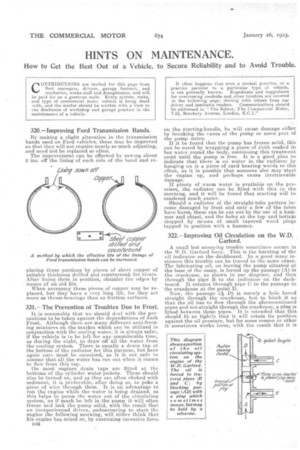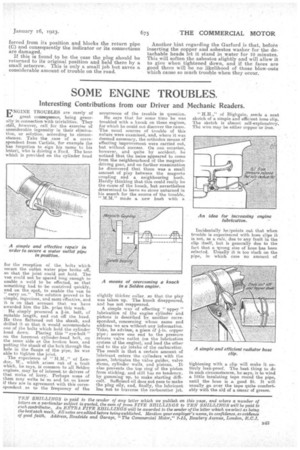HINTS ON MAINTENANCE.
Page 28

Page 29

If you've noticed an error in this article please click here to report it so we can fix it.
How to Get the Best Out of a Vehicle, to Secure Reliability and to Avoid Trouble.
CONTRIBUTIONS are invited for this page from fleet managers, drivers, garage foremen, and mechanics, works staff and draughtsmen, and will be paid for on a generous scale. Every system, make, and type of commercial motor vehicle is being dealt with, and the matter should be written with a view to the disclosure of workshop and garage practice in the maintenance of a vehicle.. It often happens that even a normal practice, or a practice peculiar to a particular type of vehicle, Is not generally known. Expedients and suggestions for overcoming roadside and other troubles are covered in the following page; dealing with letters from our driver and mechanic readers. Communications should be addressed to The Editor, The Commercial Motor, 7-15, Rosebery Avenue, London, E.C.1."
320.—Improving Ford Transmission Bands.
By making a slight alteration in the transmission bands used on Ford vehicles, these may be improved so that they will not require nearly so much adjusting, and need not be replaced so often.
The improvement can be effected by sawing about 2 ins, off the lining of each side of the band and re..
placing these portions by pieces of sheet copper of suitable thickness drilled and countersunk for rivets. After fixing them in position, chamfer the edges by means of an old file.
When necessary these pieces of copper may be replaced, but they have a very long life, for they act more as thrust-bearings than as friction surfaces.
32I.—The Prevention of Troubles Due to Frost.
It .is seasonable that we should deal with the precautions to be taken against the depredations of Jack Frost. Although there are many different anti-freezing Mixtures on the market which can be utilized in conjunction with the cooling water, it is always safer, if the vehicle is to be left for any considerable time, as during the night, to draw off all the water from the cooling system. There is usually a drain tap at the bottom of the radiator for this purpose, but here again care must be exercised, as it is not safe to assume that all the water has run out when it ceases to flow from this tap.
On most engines drain taps are fitted at the bottoms of the cylinder water-jackets. These should also be turned on, and as they are often choked with sediment, it is preferable, after doing so, to poke a piece of wire through them. It is an advantage to run the engine while the water is being drained, as this helps to pump the water out of the circulating system, as if much.be left in the pump it will often freeze and lock the pump solid, with the result that an inexperienced driver, endeavouring to start the, engine the following morning, will 'either think that his engine has seized or, by exercising excessive force
3342
on the starting-handle, he will cause damage either by breaking the vanes of the pump or some part of the pump urive. If it be found that the pump has frozen solid, this can be cured by wrapping a piece of cloth soaked in hot water round the body, continuing this treatment ment until the pump is free. It is a good plan to i
indicate that there s no water in the radiator by hanging on it a piece of card bearing words to this effect, as it is Possible that someone else may •start the engine up, and perhaps cause irretrievable damage.
If plenty of warm water is available on the premises, the radiator can be filled with this in the morning, and it will be found that starting will be rendered much easier.
Should a radiator of the straight-tube pattern become damaged by frost and only a few of the tubes have burst, these can be cut out by the use of a hammer and chisel, and the holes at the top and bottein stopped by means of small tapered wood plugs tapped in position with a hammer.
322.--Improving Oil Circulation on the W.D.
Garford.
A small but annoying trouble sometimes occurs in the W.D. Garford lorry. This is the bursting of the oil indicator on the dashboard. In a good many instances this trouble can be traced to the same cause. The lubricating oil, on leaving the pump situated at the base of the sump, is forced up the passage (A) in the crankcase, as shown in our diagram, and then through the pipe B to the indicator on the dashboard. It returns through pipe C to the passage in the crankcase at the point D.
Now, the passage (4 I)) is merely a -bole bored straight through the crankcase, but to block it so that the oil has to flow through the aforementioned pipes and not straight through the crankcase, a plug is fitted between these pipes. It is intended that this should fit so tightly that it will retain its position against the oil pressure, but for some reason or other. it sometimes works loose, with the result that it is forced from its position and blocks the return pipe (C) and consequently the indicator or its connections are damaged.
If this is found to be the case the plug should be returned to its original position and held there by a small setscrew. This is only a small job but saves a considerable amount of trouble on the road. Another hint regarding the Garforcl is that, befoie inserting the copper and asbestos washer for the detachable heads let it stand in water for lo minutes. This will soften the asbestos slightly and will allow it to give when tightened down, and if the faces are good there will be no likelihood of those blow-outs which cause so much trouble when they occur.






























